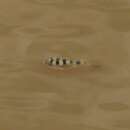Diagnostic Description
(
Inglês
)
fornecido por Fishbase
Body except for snout, pectoral base and caudal peduncle covered with prickles; teeth fused into plates, two plates on each jaw; nostril with two openings; body dark green dorsally with six transverse black bars, white ventrally; fins dusky green or dark brown (Ref. 13608).
- licença
- cc-by-nc
- direitos autorais
- FishBase
- Recorder
- Cristina V. Garilao
Diseases and Parasites
(
Inglês
)
fornecido por Fishbase
White spot Disease. Parasitic infestations (protozoa, worms, etc.)
- licença
- cc-by-nc
- direitos autorais
- FishBase
Morphology
(
Inglês
)
fornecido por Fishbase
Dorsal spines (total): 0; Dorsal soft rays (total): 11 - 12; Analspines: 0; Analsoft rays: 11
- licença
- cc-by-nc
- direitos autorais
- FishBase
- Recorder
- Cristina V. Garilao
Biology
(
Inglês
)
fornecido por Fishbase
Solitary or in groups of 2 or 3 individuals but never in schools (Ref. 35237). Inhabits shallow inshore waters usually on soft bottoms. Frequently found in freshwater (Ref. 13608). When threatened, it becomes inflated like a balloon, in order to ward off predators. Carnivorous, feeding mainly on mollusks which crushes with its powerful teeth (Ref. 35237). Of negligible commercial importance and usually not marketed (Ref. 5217).
- licença
- cc-by-nc
- direitos autorais
- FishBase
Colomesus psittacus
(
Inglês
)
fornecido por wikipedia EN
Colomesus psittacus, the Banded puffer, parrot puffer[2] or South American estuarine puffer,[3] is a species of pufferfish found all along the Western Atlantic coastline of South America from the Gulf of Paria down to the mouth of the Amazon River in Brazil.
Description
The coloration of this fish is green above, white below, and patterned with black transverse bands across the dorsal surface. Compared with Colomesus asellus, the black bands on the back are much thinner, and it also lacks a distinctive black band that rings the base of the caudal fin.[2] This species grows to a length of 28.9 centimetres (11.4 in) SL.[4] This species is known to have edible flesh but a toxic liver but whether it contains saxitoxin or tetrodotoxin (as is the case with many marine puffers) is not known.[5]
Ecology
It is a euryhaline species that moves freely between freshwater and the sea. The natural diet of Colomesus psittacus is carnivorous and consists mainly of molluscs.[4] In the aquarium they eat a variety of invertebrates including snails, clams and shrimps.[3] Like other pufferfish, they have the ability to inflate themselves when threatened, making themselves much larger and therefore more difficult for predators to handle or swallow.
Aquarium keeping
Because of its large size and need for salt water, Colomesus psittacus is rarely kept in home aquaria, but it is otherwise similar to Colomesus asellus in terms of maintenance.[6] It is not a schooling species and may be aggressive towards others of its species, so is usually kept alone.[4]
References
-
^ Shao, K.; Liu, M.; Jing, L.; Hardy, G.; Leis, J.L.; Matsuura, K. (2020). "Colomesus psittacus". IUCN Red List of Threatened Species. 2020: e.T193650A176220100. doi:10.2305/IUCN.UK.2020-3.RLTS.T193650A176220100.en. Retrieved 20 November 2021.
-
^ a b Ebert, Klaus (2001). The Puffers of Fresh and Brackish Water. Aqualog. ISBN 3-931702-60-X.
-
^ a b Monks, N., ed. (2006). Brackish Water Fishes. TFH. ISBN 0-7938-0564-3.
-
^ a b c Froese, Rainer; Pauly, Daniel (eds.) (2012). "Colomesus psittacus" in FishBase. October 2012 version.
-
^ J. C. Freitas (2006). "Eating habits: are we safe to consume freshwater puffer fish from the Amazon region in Brazil?" (PDF). Journal of Venomous Animals and Toxins Including Tropical Diseases. 12 (2): 153–155. doi:10.1590/s1678-91992006000200001.
-
^ "Colomesus psittacus". Archived from the original on February 23, 2007. Retrieved February 16, 2007.

- licença
- cc-by-sa-3.0
- direitos autorais
- Wikipedia authors and editors
Colomesus psittacus: Brief Summary
(
Inglês
)
fornecido por wikipedia EN
Colomesus psittacus, the Banded puffer, parrot puffer or South American estuarine puffer, is a species of pufferfish found all along the Western Atlantic coastline of South America from the Gulf of Paria down to the mouth of the Amazon River in Brazil.
- licença
- cc-by-sa-3.0
- direitos autorais
- Wikipedia authors and editors

